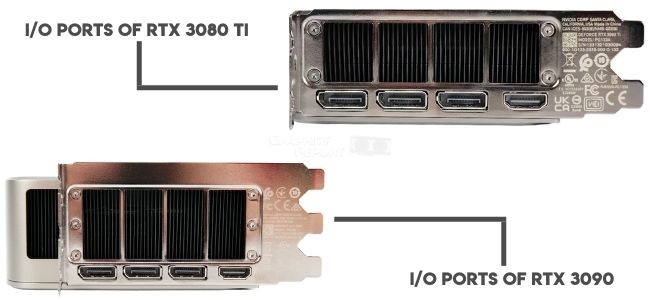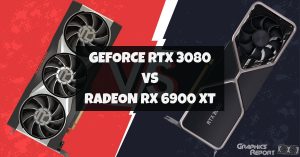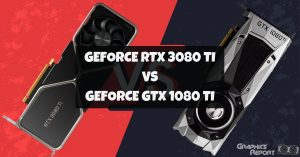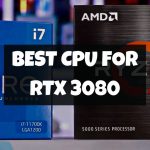
There is no denying that the RTX 3080 Ti and the RTX 3090 are among the most prolific GPUs that you can get your hands on.
After all, these are the pinnacles of what Nvidia is able to do, and sure, we also have the RTX 3090 Ti roaming the market, but the 3080 Ti changed a lot for Nvidia and managed to become one of the most, if not the most popular GPU in the market, and honestly, for all the right reasons.
Now, the thing is that a lot of the times, people who are in the market looking to buy a GPU are often confused when it comes to 3080 Ti vs 3090 there is a huge price difference between both of these, but the performance difference is not enough to warrant a higher price.
Therefore, I’m here to break things down for you and will tell you which one you should be going for.
3080 Ti vs 3090: General Specifications
| GPU Name | RTX 3080 Ti | RTX 3090 |
|---|---|---|
| Price | Check Price | Check Price |
| CUDA CORES | 10240 Units | 10496 Units |
| Base Clock | 1365 MHz | 1395 MHz |
| Boost Clock | 1665 MHz | 1695 MHz |
| V-RAM | 12GB GDDR6X | 24GB GDDR6X |
| Memory Interface | 384-bit | 384-bit |
| Power Consumption | 350W | 350W |
| Required PSU | 750W/850W | 750W/850W |
| Dimensions | 285 x 112 x 40 mm | 313 x 138 x 50 mm |
Now, coming towards the general specifications of both GPUs, it is safe to say that you are going to see some discrepancies.
For instance, the 3080 Ti brings in only half of VRAM as compared to the 3090 but is this half really bad, or is there something else at play? Let’s look deeper into it.
On the other hand, the 3090 does not differ a lot in terms of performance specifications either, so we are going to have a look.
You can clearly tell that the general specifications are not all different. But hey, I’m going to make it easier for you to understand the comparison of these two GPUs.
3080 Ti vs 3090: Clock Speeds And Memory
Now that we are done talking about the general specifications, it is time to dig deeper and learn more about both the RTX 3080 Ti and the RTX 3090.
I can easily tell you that these GPUs are nothing to slouch about as they are known for delivering excellent performance, and the value for money is just as great. With that said, let’s look at what we have.
The RTX 3080 Ti comes with a base clock of 1365 MHz and a boost of 1665 MHz; however, it is important to note that thanks to GPU boost, you are going to get significantly higher boost clocks, and in custom variants, the boost clock will be even higher. As for memory, it uses a 12GB GDDR6X memory.
For the RTX 3090, we are looking at a base of 1395 MHz and a boost of 1695 MHz. However, this one uses 24 gigs of GDDR6X VRAM. One would think that this means that you are getting a lot more performance, but we have all come to know that this is not how VRAM scales in terms of performance.
Still, both the RTX 3080 Ti and the RTX 3090 are excellent performers in their own rights, and I’m going to go further and discuss more.
Related reading: Nvidia RTX 3080 vs 3080 ti in 2023
3080 Ti vs 3090: Features And Ports
While not as common, when people are buying a GPU, they do want to have some good features along with it, as well. Now with GPUs, you normally look at two types of features; ones that are built into the GPU, such as the technologies that are being used well, and others that are introduced by the add-in-board partner.
For instance, Raytracing and DLSS are something that you will find in all the RTX 3000 series GPUs as well as RTX 2000 series GPUs. However, various RGB lighting, coolers, and other implementations will vary.

With that said, the RTX 3080 Ti brings a single HDMI 2.1 and three DisplayPort 1.4a, and the same configuration can be found on the RTX 3090 as well.
As far as the features are concerned, both GPUs have full support for Raytracing, DLSS, machine learning, and all the other features that Nvidia introduced with Ampere.
3080 Ti vs 3090: Power Consumption And Temperatures
With Nvidia’s Ampere architecture, we saw the efficiency being taken to the next level; all the RTX 3000 cards consumed the same amount of power as their predecessors, but this time around, they managed to deliver a better overall performance. However, that does not mean that they do not consume a lot of power because, simply put, they actually do.
While I would not call it bad by any means, you should know that both the RTX 3080 Ti and the RTX 3090 are power-hungry cards, and it would be better if you are using a 750W+ power supply so you can get the perfect results. I know, it does sound like a lot, but hey, if you want performance, you have to spend money.
As far as the temperatures are concerned, almost all the RTX 3080 Ti and the RTX 3090 that I have tested, I did not run into any temperature issues or thermal throttling, for that matter. Needless to say, everything ran perfectly.
A similar read: RX 6800 xt vs RTX 3080 in 2023
3080 Ti vs 3090: Price And Availability
Now, when you are talking about the pricing and availability for the RTX 3080 Ti and the RTX 3090, things get a bit funny. Why? Well, finding these GPUs at MSRP used to be almost next to impossible. However, the GPU market is finally getting stable, and we are finally seeing better availability with the prices coming down, as well.

So, if you are looking to get your hands on the 3080 Ti, you are looking at around $1,200 for the reference variant. However, if you want 3rd party offerings from the likes of MSI, Asus, Gigabyte, and other companies, you are likely to spend more money.
If you are looking to go for the RTX 3090, you are looking to spend around $1,500 for the reference version, with the price steadily climbing for 3rd party variants.
I would always suggest going for a 3rd party variant as you tend to get much better performance and extra perks such as better temperatures, clock speeds, and aesthetics, as well.
Testing Setup:
Using the right test setup is one of the most important aspects, and you cannot just go ahead and use something that is average, at best.
That is why I’m going to make sure that both the RTX 3080 Ti and the RTX 3090 are getting a fair treatment, and I’m using proper hardware for these GPUs. You can check out the specs below.
- CPU: i9 11900K 11TH GEN 8c/16t
- GPU: RTX 3080 Ti 12GB/RTX 3090 24GB
- RAM: Crucial RAM 16 GB (2×8) Dual Channel 3600 Mhz CL 40
In terms of the specs, I am not slouching back because I need the best of every case.
3080 Ti vs 3090: Gaming Performance & Benchmarks
1- Minecraft Ray Tracing (1080p)
There is no denying that Minecraft has come a long, long way, and the modern-day game that you see is completely different. Especially when you turn on Raytracing, then the game totally becomes different and demanding, too.
With that said, the RTX 3080 Ti averages at around 148 frames per second, and the RTX 3090 goes only as high as 150 frames per second; and considering how there is a bottleneck here, I’m ought to see some performance difference as I go for higher resolutions.
- RTX 3080 Ti: 148 FPS
- RTX 3090: 150 FPS
1.1- Minecraft Ray Tracing (1440p)
Moving onto 1440p, you would be hard-pressed to know that the difference is not all that much as there is only a 2% difference. The RTX 3080 Ti scores 131 frames per second, and the RTX 3090 manages to gain as high as 134 FPS. The difference is not all that much, but it is at higher resolutions when I finally start seeing things happening differently.
- RTX 3080 Ti: 131 FPS
- RTX 3090: 134 FPS
1.2- Minecraft Ray Tracing (4k)
The story is not so different on 4K, either. One would assume that you will start seeing a difference at a higher resolution, but that is not the case.
The RTX 3080 Ti at 4K manages 93 on average, whereas the RTX 3090 manages around 96 frames per second on average, marking a difference of just 3%. Again, almost all the frame rates that you see are excellent; it’s just the difference is barely there.
- RTX 3080 Ti: 93 FPS
- RTX 3090: 96 FPS
2- Days Gone (1080p)
Days Gone is one of my favorite games as it allowed me to live the life of a biker but, at the same time, a zombie-killing beast. I know the game received critical panning, but in reality, the game is amazing.
With that said, the game managed a respectable 167 frames per second on average for the RTX 3080 Ti, and for the RTX 3090, I got an average of 172 frames per second.
Not a substantial increase in framerate but one that can definitely make a difference at higher resolutions.
- RTX 3080 Ti: 167 FPS
- RTX 3090: 172 FPS
2.1- Days Gone (1440p)
Moving onto 1440p, the song does not remain the same because this time around, here as you can see we have an average of 131 frames per second for the RTX 3080 Ti and 134 frames per second for the RTX 3090.
A difference that is barely there, to begin with. Still, we have come to know that at higher resolutions, every last drop of the frame matters a lot.
- RTX 3080 Ti: 131 FPS
- RTX 3090: 134 FPS
2.2- Days Gone (4K)
Things do not change at 4K, either. The most demanding resolution there is to see almost no difference but here, every frame matters.
Days Gone manages to deliver 77 frames per second on the RTX 3080 Ti and 80 frames per second on the RTX 3090. Again, the difference is merely 4%, but it might make a lot of difference to some that want every bit of performance.
- RTX 3080 Ti: 77 FPS
- RTX 3090: 80 FPS
3- Shadow of the Tomb Raider (1080p)
There is no way to deny that Shadow of the Tomb Raider is one of the better games, and well, it deserves the praise as it also looks gorgeous.
With that said, you can expect to get around 138 frames per second on average when you are running an RTX 3080 Ti and 142 frames per second when you are running an RTX 3090. The difference is surely there, but it is not a lot to make a difference in the first place.
- RTX 3080 Ti: 138 FPS
- RTX 3090: 142 FPS
3.1- Shadow of the Tomb Raider (1440p)
The difference becomes even smaller when moving onto 1440p, to be honest. The Shadow of Tomb Raider, running at 1440p, manages to deliver 113 frames per second for the RTX 3080 Ti, and for the RTX 3090, you are looking at an average of 116 frames per second. Not a bad score for both cards, but the difference can be looked at within the margin of error.
- RTX 3080 Ti: 113 FPS
- RTX 3090: 116 FPS
3.2- Shadow of the Tomb Raider (4k)
Things do not change all that much when you move over to 4K, as one would assume. The RTX 3080 Ti scores a more than impressive 75 frames average, whereas you are getting a 78 frames average with the RTX 3090.
Sure, you might be hoping for a larger difference, but it simply is not there this time around, and that is perfectly normal.
- RTX 3080 Ti: 75 FPS
- RTX 3090: 78 FPS
4- Control (1080p)
Control happens to be one of the most demanding games and one of the best showcases of all the modern graphical fidelity that you can want.
With that said, for those who are looking to go ahead and play Control, the RTX 3080 Ti will deliver 137 average FPS, and the RTX 3090 will deliver 144 average FPS.
Needless to say, the scores are plenty for anyone who is looking for a good overall gaming experience, and things are not really going to run into any problems.
- RTX 3080 Ti: 137 FPS
- RTX 3090: 144 FPS
4.1- Control (1440p)
Moving onto 1440p, I was able to see that the gap got smaller here, and while this might be alarming for some, it is a pattern that I have been seeing. The RTX 3080 Ti manages to get 123 frames per second as an average, whereas the RTX 3090 gets 127 frames per second.
Sure, the difference is there, but it is not enough to make a massive difference to begin with. Therefore, you must keep this in mind before going forward.
- RTX 3080 Ti: 123 FPS
- RTX 3090: 127 FPS
4.2- Control (4k)
For those wondering, things are not going to change when you are playing at 4K either. The resolution is definitely the most demanding, but hey, we are still looking at great results overall, and we cannot really deal with something that is bad. Still, let’s have a look, shall we?
For starters, you are getting an average of 69 frames per second with the RTX 3080 Ti, and with the RTX 3090, you are getting 71 frames per second. The difference is minimal, sure. But it can easily make a difference, considering how every frame matters a lot.
- RTX 3080 Ti: 69 FPS
- RTX 3090: 71 FPS
5- Assassin’s Creed Valhalla (1080p)
Assassin’s Creed Valhalla is easily one of my favorite Assassin’s Creed games, and much like the predecessors, it is also demanding in terms of the horsepower that you are running.
After all, there is little to no point in getting something that will not perform accordingly, and it is better to have something that is good.
The RTX 3080 Ti manages to get around 96 frames per second on average and 99 for the RTX 3090. We are off to a rather slow start, but once you play the game, you will realize why that is the case.
- RTX 3080 Ti: 96 FPS
- RTX 3090: 99 FPS
5.1- Assassin’s Creed Valhalla (1440p)
At 1440p, you look at a similar scenario as well since the game does not make all that much difference here in terms of performance, either. However, that does not mean we are just going to go ahead and overlook it to begin with.
You are getting around 81 frames per second on RTX 3080 Ti, and for the RTX 3090, you are getting around 84 frames per second. A very small difference but definitely something that is worth keeping in mind.
- RTX 3080 Ti: 81 FPS
- RTX 3090: 84 FPS
5.2- Assassin’s Creed Valhalla (4k)
We are now heading towards 4K, and this time around, the performance difference is there, but as you would expect, the difference is such that both cards are performing under 60 FPS. Yes, the game really is demanding.
You are getting an average of 57 frames per second on RTX 3080 Ti, and for the RTX 3090, you are getting a 59 FPS average. Here, this 3% difference means a lot since we are talking about 4K, and every frame matters here.
- RTX 3080 Ti: 57 FPS
- RTX 3090: 59 FPS
My Final Thoughts On It!
I am fully aware of the fact that the choice between the RTX 3080 Ti and the RTX 3090 can be a confusing one for a lot of people. Many people would not mind paying $300 more for extra performance, but to be honest, things are not as straightforward as one might think.
It is true that for a premium, you are getting twice the VRAM with the RTX 3090, but you have to ask yourself if the performance difference you are getting is worth the price and if this guide is anything to go with, it is safe to say that it is not the case.








